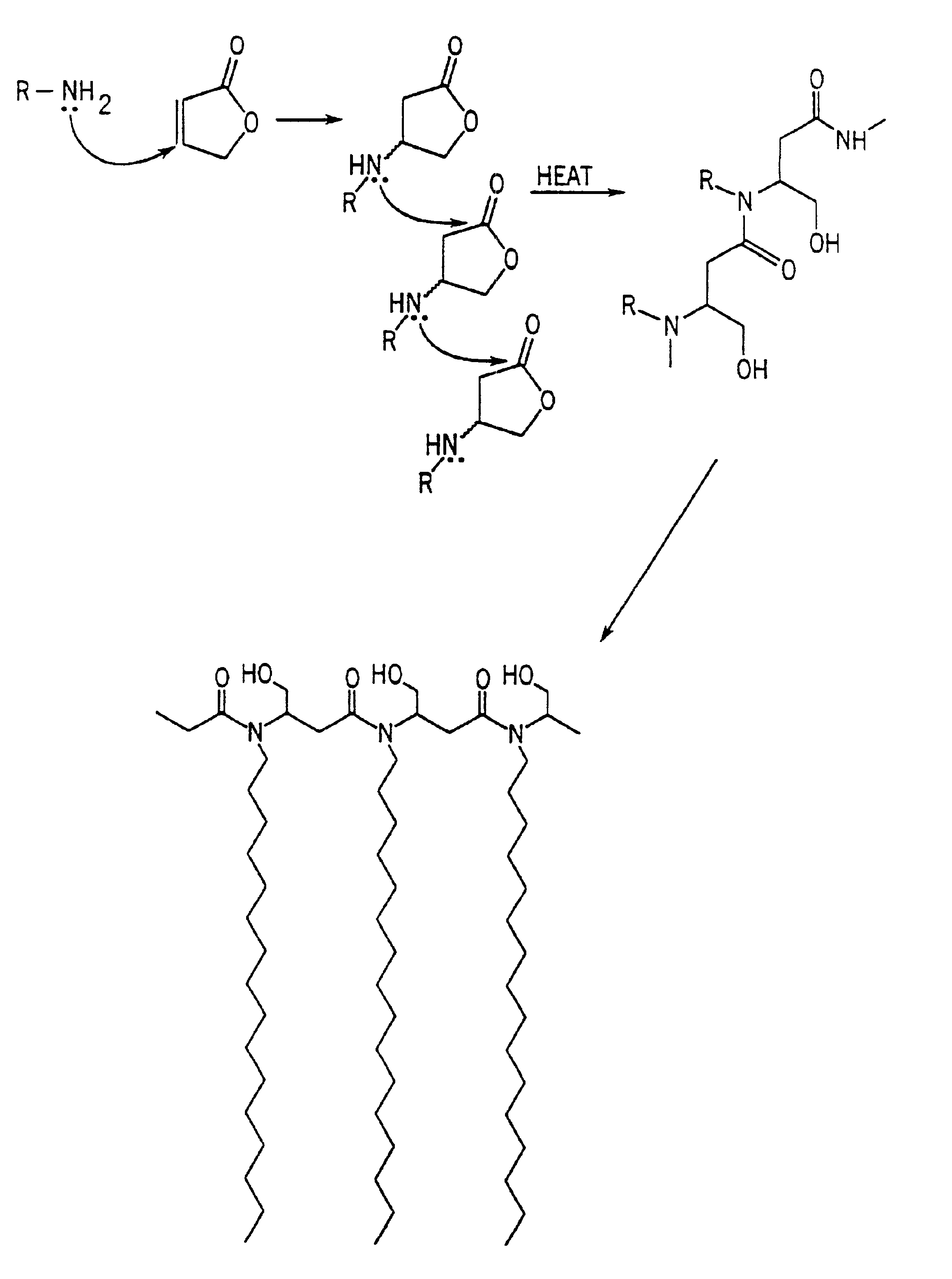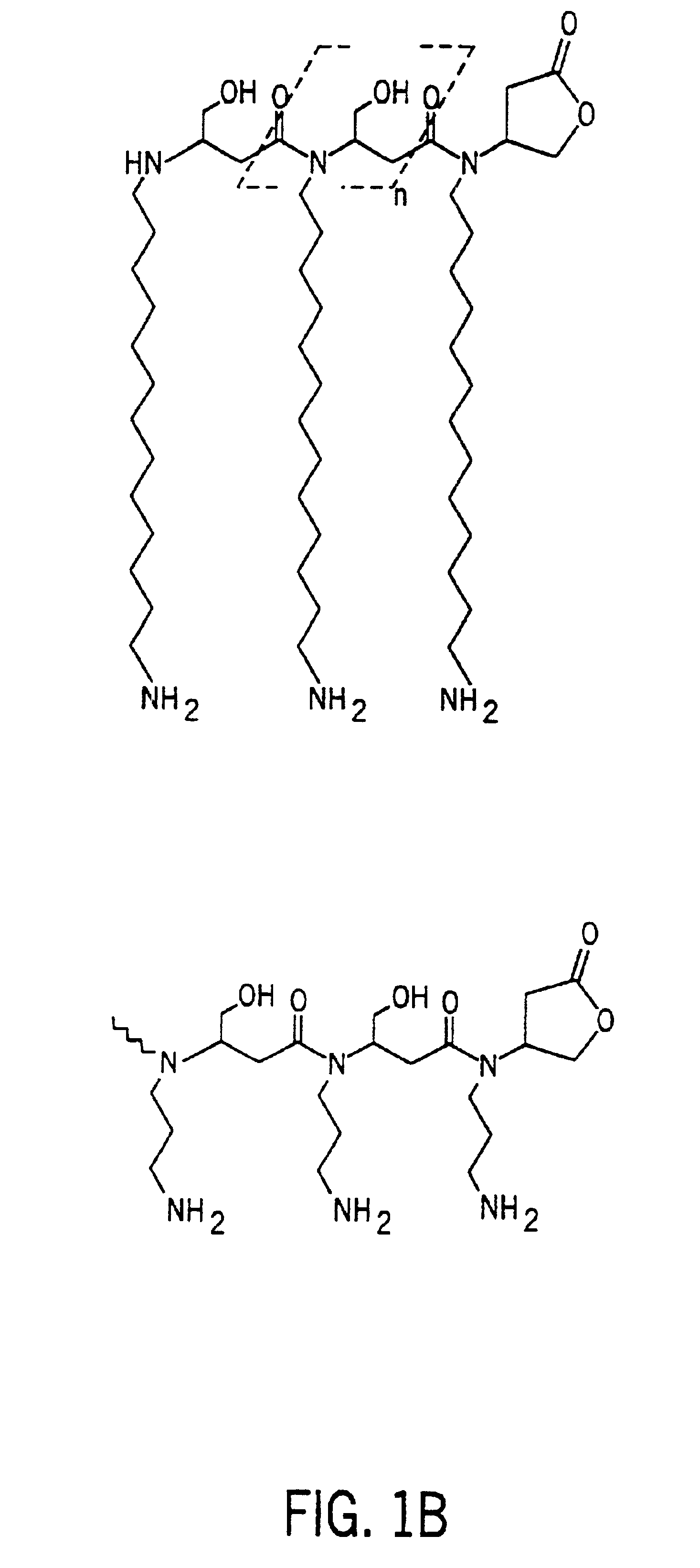Antimicrobial polymer
- Summary
- Abstract
- Description
- Claims
- Application Information
AI Technical Summary
Benefits of technology
Problems solved by technology
Method used
Image
Examples
example 1
Preparation of a Substrate Having a Crosslinked Polyamide Coating Including a Quaternary Ammonium Compound
[0049]A 3% solution of the polyamide with side chains as prepared in the Control Example was prepared in isopropanol. A polymer coating solution was then prepared by mixing 110 milliliters of the 3% solution of the polyamide, 4 milliliters of a 50 mg. / ml. hydroquinone in isopropanol solution, 1 milliliter of 50 mg. / ml. Triton™ X-100 brand non-ionic surfactant in isopropanol, 3 milliliters of 50% glutaraldehyde, 0.4 milliliters of triethylamine, and 0.4 milliliters of 80% tetrakis(hydroxymethyl)-phosphonium chloride. A surface modified substrate as prepared in the Control Example was then dipped in the polymer coating solution and heated by hot air at 120°-150° C. for 1 minute.
[0050]The coated substrate was then incubated for 1 hour in a solution of 0.75 grams of 2-sulfobenzoic anhydride, 150 milliliters of 50 mM phosphate buffered saline (pH=7.4), 10 milliliters of isopropanol, ...
example 2
Preparation of a Substrate Having a Crosslinked Polyamide Coating Including a Gentian Violet Compound
[0052]A 3% solution of the polyamide with side chains as prepared in the Control Example was prepared in isopropanol. A polymer coating solution was then prepared by mixing 110 milliliters of the 3% solution of the polyamide, 4 milliliters of a 50 mg. / ml. hydroquinone in isopropanol solution, 1 milliliter of 50 mg. / ml. Triton™ X-100 brand non-ionic surfactant in isopropanol, 3 milliliters of 50% glutaraldehyde, 0.4 milliliters of triethylamine, and 0.4 milliliters of 80% tetrakis(hydroxymethyl)-phosphonium chloride. A surface modified substrate as prepared in the Control Example was then dipped in the polymer coating solution and heated by hot air at 120°-150° C. for 1 minute.
[0053]The coated substrate was then incubated for 1 hour in a solution of 0.75 grams of 2-sulfobenzoic anhydride, 150 milliliters of 50 mM phosphate buffered saline (pH=7.4), 10 milliliters of isopropanol, 0.1 g...
example 3
Preparation of a Substrate Having a Crosslinked Polyamide Coating Including a Gentian Violet Compound
[0055]A 3% solution of the polyamide with side chains as prepared in the Control Example was prepared in isopropanol. A polymer coating solution was then prepared by mixing 110 milliliters of the 3% solution of the polyamide, 4 milliliters of a 50 mg. / ml. hydroquinone in isopropanol solution, 1 milliliter of 50 mg. / ml. Triton™ X-100 brand non-ionic surfactant in isopropanol, 3 milliliters of 50% glutaraldehyde, 0.4 milliliters of triethylamine, and 0.4 milliliters of 80% tetrakis(hydroxymethyl)-phosphonium chloride. A surface modified substrate as prepared in the Control Example was then dipped in the polymer coating solution and heated by hot air at 120°-150° C. for 1 minute. The coated substrate was then incubated for 16 hours at room temperature in a solution of 50 milliliters of 0.3% dimethylgentian violet, 150 milliliters of tris(hydroxymethyl)-phosphine and 10 milliliters of is...
PUM
| Property | Measurement | Unit |
|---|---|---|
| Antimicrobial properties | aaaaa | aaaaa |
| Polymeric | aaaaa | aaaaa |
Abstract
Description
Claims
Application Information
 Login to View More
Login to View More - R&D
- Intellectual Property
- Life Sciences
- Materials
- Tech Scout
- Unparalleled Data Quality
- Higher Quality Content
- 60% Fewer Hallucinations
Browse by: Latest US Patents, China's latest patents, Technical Efficacy Thesaurus, Application Domain, Technology Topic, Popular Technical Reports.
© 2025 PatSnap. All rights reserved.Legal|Privacy policy|Modern Slavery Act Transparency Statement|Sitemap|About US| Contact US: help@patsnap.com



